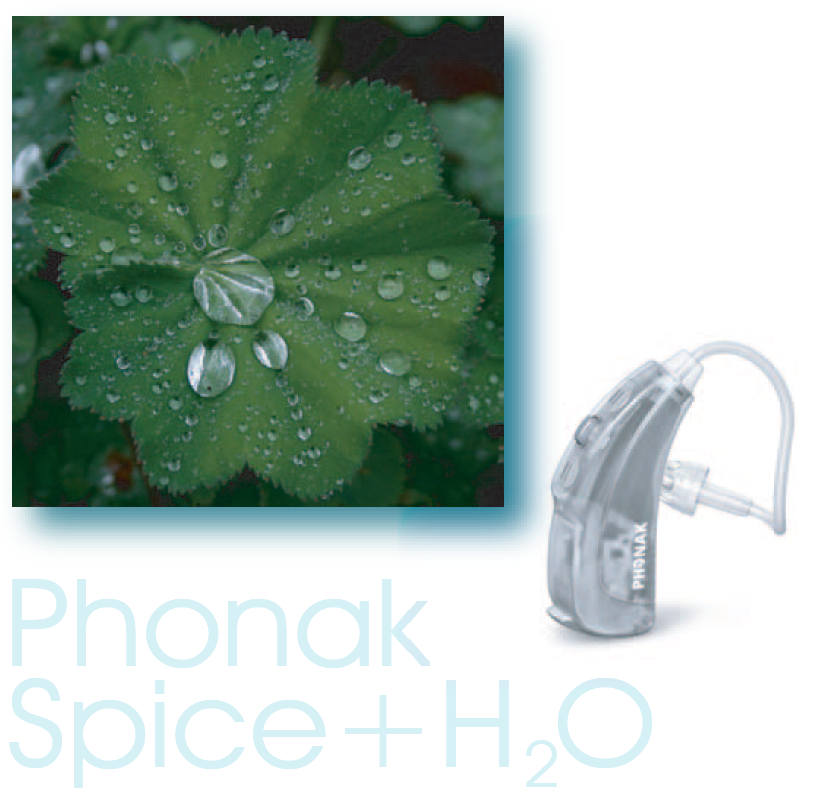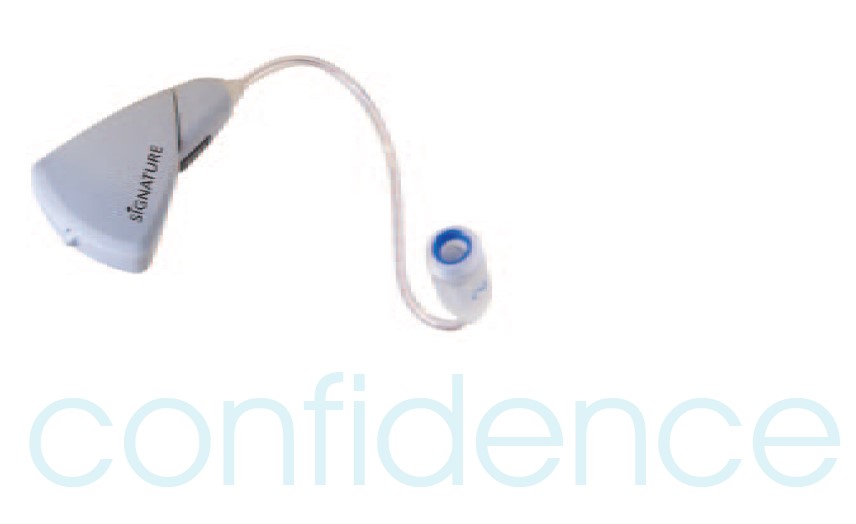Sound Sense
Issue 10

Inside this issue
- Swimmer’s ear
- Signature 960 – as individual as you
- iCom – the communication interface
- When the ear has the sniffles – Otitis Media
Making a splash
new water and dirt resistant hearing aids
There has long been a wish to have robust, reliable hearing aids that are resistant to water, perspiration, moisture and dirt. This in practice means, not having to think about whether you can wear them at work on a building site, gardening, during heavy rain, playing sports and on the beach. At the same time aesthetics remain a high priority for many people and this has to be considered in the design of any new hearing aids.
Towards the end of 2011 Phonak introduced the Spice+H2O hearing aids which have been awarded a rating of IP67 on the International Electrotechnical Commission (IEC) 60529/EN60529 ingress protection standard.
The first number on the code (6) indicates the level of protection against solid objects such as dust, while the second number (7) indicates the level of protection against liquids or moisture. This certification is performed by independent institutes that test and evaluate products across a broad range of equipment and can be considered a good indicator of the dust and water tightness of a device.
The new Spice+H2O hearing aids cover a wide range of performance and price points from the Ambra M H2O, Solana M H2O, Cassia M H2O, to the Naida S CRT, an external receiver hearing aid for those who do not want to compromise when it comes to a powerful, yet discreet hearing solution. Spice + processing aims to offer a pleasing overall sound experience while fostering the best possible speech intelligibility.
Among the key benefits are a better fitting formula to address those with mild to moderate hearing losses and further refinement to allow for more natural hearing in quiet situations as these quiet situations actually change more often than is realised. In keeping with the design brief the portfolio is available in a new-micro sized housing which has resulted in small easy to mange hearing aids. The demands on the new hearing aids housings were very high and were met through a combination of housing design, materials used and nano-coating. Even if
accidentally worn in the shower, there is peace of mind and security in knowing that the sensitive electronics of the hearing aids are well protected.
However there are also limits and strong forces from contact with water such as during waterskiing or surfing can damage microphones. The hearing aids are not suitable for diving, due to the rapidly changing water pressure. Contact with soap and hairspray should also be avoided as it can affect the membrane and block the air circulation of the battery compartment.
We have fitted a number of these technologically innovative aids and have received a positive response.

Swimmer’s Ear
Swimmers ear is a common but preventable condition of the ear canal. The medical term for swimmers ear is ‘Exostosis’, which is a bony growth under the skin layer of the ear canal that occurs when the bone is exposed to cold temperatures over many years. Cold air blowing over wet skin lowers the temperature by evaporation and stimulates bony growth in an effort to close and protect the ear canal. It can occur from sporting activities such as swimming, surfing, kite surfing, wake-boarding, white water kayaking, body-boarding and wind-surfing.
Prevalence
It is six times more common here than in the tropics and can became apparent after just five years of regular swimming. The condition is more common in males than females with symptoms presenting between the mid to late thirties. The more frequently you swim, the more likely you are to develop it.
Symptoms of Swimmers Ear
- A persistent feeling of fullness
- Difficulty clearing water from the ears after swimming
- Difficulty Hearing
Risk Factors
Certain materials in wetsuits, boots and gloves: these make it easier to stay in the water for longer.
Participating in water based activities during the colder months: lower temperatures and prevailing winds create a higher risk.
Implications of Swimmers Ear
The bony growth can eventually cause partial or even complete blockage of the ear canal. The canal can consequently trap water and debris causing painful ear infections which may become recurrent and difficult to treat.
Management
In mild cases the GP may prescribe antibiotics and an Ear, Nose and Throat consultant may clean out the ears to remove any water and debris. In more severe cases one may need surgical intervention: Canaloplasty involves creating a hole in the bone behind the ear and drilling out the bony lumps. Newer techniques such as canal ‘chipping’ are now emerging.
Prevention
Keep ears warm and dry when swimming by using earplugs which we regularly fit, Many people like to take the added precaution of wearing a bathing cap.

Signature 960
as individual as you
Your ability to hear clearly impacts on countless aspects of your well-being and quality of life. Not only is your hearing loss individual, but your lifestyle, hobbies and interests are all unique to you, and influence the hearing solution that is best for you. One such solution is the Signature 960 Receiver-in-the-Ear hearing aids. They are very small so cosmetically appealing. They have unique processing power and new protective technology which guards against rain water, showering, shock and vibration.
In providing an excellent and reliable solution, the Signature 960’s strike the ideal balance between audibility, intelligibility and sound quality. Surround Sound is one of the sophisticated features of these hearing aids and this greatly enhances the wearer’s ability to understand speech in noise. The only clinically proven solution to improving speech in noisy environments is to use directional microphones in hearing aids. Like a surround sound system, sound is streamed into bass or low frequency sounds, and treble or high frequency sounds. This allows the directional microphones in the hearing aids to be used to provide firstly a richer sound quality without distortion, feedback, internal noise and wind noise and secondly improved awareness and ability to locate where sounds are coming from.
Noise Tracker 11 recognises and dampens background noise making sound comfortable and speech more recognizable. All hearing aids now have methods of reducing annoying whistle or feedback but not all of these work in the same way. However, DFS Ultra in the Signature 960 works on the dual microphones simultaneously and does not compromise sound quality at the expense of gain or power. The Environmental Optimiser automatically moves between seven listening environments allowing for a full range of situations without having to make any manual adjustments.
People wearing the Signature range of hearing aids have suggested that they provide an excellent solution, fostering the best possible speech intelligibility with more confidence.

iCom
the communication interface
Leading an active life and keeping in touch with our environment means being able to interface with a diverse range of communication systems such as telephones, televisions, MP3 players, GPS, computer and other audio sources.
iCom was introduced for a wide range of entertainment and communication devices in 2009 to wirelessly receive audio from Bluetooth-enabled devices such as mobile phones and personal computers. For non-Bluetooth equipment the iCom receives audio from devices such as a stereo or home phone by connecting with devices such as an MP3 player or radio via a standard audio jack.
The latest addition to this system is the Phonak TVLink base station which was specifically developed to provide a stable, fast high quality Bluetooth signal transmission for optimal TV enjoyment and it doubles as a charging cradle
for the iCom – one power supply for two devices. The Phonak TVLink base station in combination with an iCom offers a very convenient way to link most Phonak hearing aids to the TV wirelessly via Bluetooth. The advantage for the wearer is that, rather than the audio from the TV going through the air, it is travelling directly into his or her hearing aids and the volume can be adjusted without interfering with anybody else’s enjoyment of the television.
If you would like further information on this iCom/TV bundle please contact us.

When the ear has the sniffles
Otitis Media
There are various types of Otitis Media. When the term “ear infection” is used it usually refers to acute Otitis Media. It is generally viral in nature, and is characterized by a rapid onset and is of relatively short duration and symptoms which includes the feeling of congestion in the ears, discomfort or a “popping sensation”. The majority of cases are mild and either resolve themselves or are easily treated with the help of your GP who may prescribe ear drops or suggest over the counter decongestants and analgesics.
More severe cases display symptoms such as hearing loss, earache or pain, dizziness, high fever, ear discharge, nausea and tinnitus and must always be treated by a doctor. Sometimes the eardrum cannot withstand the pressure from the build up of fluid and it tears, resulting in a perforated eardrum. This tear allows the fluid to flow out bringing relief and perforations can often heal of their own accord. Following a suitable course of antibiotics Otitis Media normally clears in two to three weeks.


One of the most obvious signs of a common cold or flu is a stuffy or runny nose What is not so obvious is that the ear can also have the sniffles! This is commonly referred to as Otitis Media or middle ear infection and is the inflammation of the middle ear. The middle ear is the area between the eardrum and the inner ear and consists of the eardrum, the hollow cavity behind it, the three tiny bones (the ossicles) and the Eustachian tube.
Otitis Media typically is a complication of upper respiratory infection such as a cold and is a very common medical condition. After a few days of a stuffy or runny nose the ears can become affected. The membrane lining the middle ear becomes inflamed and the Eustachian tube which connects the middle ear to the back of the throat closes up.
This in turn affects the air circulation in the middle ear, causing a build up of negative pressure which creates a vacuum. In some cases if this does not resolve itself the inflamed membrane begins to secrete fluid.
It is worth keeping in mind that a runny nose may also lead to an ear with the sniffles.
Request an Appointment
Request an Appointment

Opening Hours
We open every weekday from 9.00 - 5.00. We close for our lunch hour From 1-2. We are closed bank holidays, St Patrick's Day and Good Friday.
Monday - Friday: 9.00 - 5.00
Saturday - Sunday: Closed
Our Address
61 Catherine Street, Limerick
Phone: +353 (0) 061 313 633
Email: info@ferghac.ie
Web: http://www.ferghac.ie
